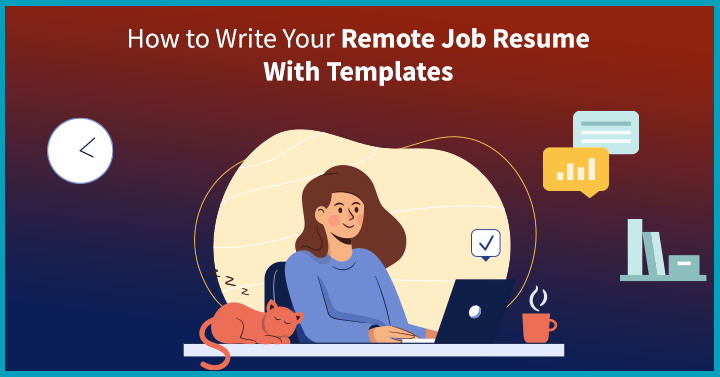You should always tweak your resume when applying for a job to make it as applicable as possible. This remains pertinent when it comes to applying for remote working opportunities. Taking time to plan how to write your remote job resume, with templates prepared beforehand, will make the whole process easier and smoother.
The first step is to consider the exact nature of remote work, in order to highlight the necessary skills for success.
1. What Is Remote Work?
How do you describe working remotely? Essentially, it’s any role that an employee does in a location outside a central office. This location could be your home, a coworking space or even a cafe, depending on the kind of work you do. Some people find a quiet, solitary room the most effective place to work; others prefer having a little bit of hustle and bustle around them to keep them from feeling isolated.
2. Why Is It Important to Tailor Your Resume for Remote Work?
While many people may want to work remotely, not everyone will have the right technical skills, self-motivational attitude or adaptable personality to do so effectively. Employers will only want to hire someone who can demonstrate the correct attributes, rather than wasting time on applicants who may not be suited to such a role.
The remote job resume objective is to improve your chances of being invited for an interview. Tailoring your resume signals to a hiring person you have what is required to succeed.
3. How to Write Your Remote Job Resume

As you’re going through your resume to adapt it for remote work job advertisements, it might be helpful to keep the following points in mind.
3.1 Research the Company Before Creating the Resume
As a precursor to adapting your resume, take some time to research the company you’re applying to. If you’re serious about the position, it’s worth the effort and will allow you to better analyze how to write your remote job resume templates to cater for the business’ ethos. This can be done by examining the organization’s website and reading any recent news stories or press releases about the company.
3.2 Include the Right Contact Information
Naturally, you’ll want to include your email address and your telephone, as well as perhaps a link to your LinkedIn profile and any other professional websites, such as a digital portfolio. Don’t leave off your partial address. While it might be a remote work job, many employers will still want to ensure you are in a particular state or country for tax purposes, or so they know you can travel in for the occasional meeting. The other requirement a company might have is that your time zone is aligned with its headquarters, so that you can be easily contactable if necessary.
3.3 Mention Your Previous Remote Work Experience and Skills
A bit of an obvious one, but you won’t want to forget to mention any previous remote work experience when you think about how to write your remote job resume templates. First, you can note this at the top of your resume in the summary. Within the body of your resume, you can then highlight it beneath each relevant job. Finally, you can bullet point your aptitude for remote working in the skills section, as well as the ability to use various forms of communication software.
3.4 Read the Job Posting Carefully and Use It to Tailor Your Resume
As with every job you apply for, the description will offer vital clues for what to highlight. Are there technical skills that are foregrounded, or are there certain soft skills that are stated as desirable? Tease these out of your previous experience. It’s also become pretty common practice for hiring managers to ask candidates to include a phrase in the subject line or first sentence of their application, in order to weed out the people who haven’t bothered to read the job posting carefully enough. Don’t get caught out!
3.5 Remove Irrelevant or Unnecessary Information
The rule of thumb for any resume is that it should not be longer than two pages. If you’ve been working for a long time, you’re bound to have lots of experience and many achievements and qualifications you want to showcase. However, not all of them are going to be relevant to the job in question. Be brutal and excise any unnecessary information, to make sure you keep your resume tight and punchy.
3.6 Make It Obvious You're Looking for a Remote Job
Not all roles you apply for will be limited to remote work applicants. Indeed, some companies advertise positions that are open to both in-office and remote candidates. Make sure you specify in your application that you’re applying as a remote worker. You can do this in your cover letter, but it’s worth highlighting it again in your resume and stating where you’re currently based for the reasons mentioned earlier.
3.7 Show Your Familiarity With Remote Collaboration Tools
As discussed above, noting down the communication software you’re familiar with is a great way to show that you have the technological skills to work from home. Refer to the job listing to see if it specifies any particular programs that the role requires, like Zoom or Slack. If it does, move those to the front of a general list of applications you know how to use. Don’t forget to include details of other collaborative tools you know, like Monday or Trello. If you have utilized these before, make sure you draw attention to the facts and contextualize them.
3.8 Emphasize Remote Skills
The skills needed for a remote job resume are fairly uniform across industries. Some of the most common are adaptability (i.e., ability to adjust to new working patterns and company-specific software), time management, communication skills (in particular written), digital savviness (including learning how to use previously unfamiliar applications) and self-motivation.
3.9 Create a Good Cover Letter for the Resume
We’ve already touched on the cover letter’s importance when it comes to making it obvious you’re looking for a remote job, but it’s also somewhere you can re-emphasize any remote work experience you have, outside of the information-filled resume. Remember that both the resume and the cover letter should address what skills you think are necessary to be a successful remote worker.
4. Remote Work Resume Templates

Once you know how to write your remote job resume, templates can help reduce the amount of time you need to spend on each application. You should still make tweaks and adjustments according to each individual job specification, but the remote job resume examples below will give you a foundation on which to build. Note that the below is general information for how to write your remote job resume with templates, but you should personalize the layout according to your preference.
4.1 Chronological Resume Template
If you are wondering which of the how to write your remote job resume templates is the most popular style used today, it’s the chronological resume. This starts with your most recent work experience and travels back from there.
[Insert full name]
[Insert email]
[Insert phone number]
[Insert address (street address not necessary, just general region)]
Summary
[A brief introduction to who you are, followed by what key qualifications and skills you want to highlight. This should be a maximum of four or five sentences. Include any relevant remote work experience.]
Professional experience
[Insert job title]
[Insert company name] [Insert office address OR note that job was remote]
[Insert date range]
- [Explain responsibilities, including if you worked as part of a remote team]
- [Detail achievement, including anything related to remote working]
- [Detail achievement]
[Insert job title]
[Insert company name] [Insert office address OR note that job was remote]
[Insert date range]
- [Explain responsibilities]
- [Detail achievement]
- [Detail achievement]
Skills
- [Insert relevant skill (including any common in-demand remote work attributes, like self-motivation and use of collaborative tools)]
- [Insert relevant skill]
- [Insert relevant skill]
Education
[Insert university name] [Insert degree]
[Insert date range]
[Insert any other notable achievements during degree, e.g., graduating summa cum laude]
4.2 Functional Resume Template
Of the remote resume samples detailed here, the functional resume is the one that focuses most on skills. It can be useful if you are switching careers but want to highlight transferable talents, have gaps in your employment or are a fresh graduate. A minimum of three skills sets is advisable (see below).
[Insert full name]
[Insert email]
[Insert phone number]
[Insert address (street address not necessary, just general region)]
Summary
[A brief introduction to who you are, followed by what key qualifications and skills you want to highlight. This should be a maximum of four or five sentences. Include any relevant remote work experience.]
Skills
[Insert skill, for example, project management or the more general organization]
- [Insert example of when you demonstrated skill (including remote-work-related scenario)]
- [Insert example of when you demonstrated skill]
- [Insert example of when you demonstrated skill]
[Insert skill, for example, project management or the more general organization]
- [Insert example of when you demonstrated skill (including remote-work-related scenario)]
- [Insert example of when you demonstrated skill]
- [Insert example of when you demonstrated skill]
[Insert skill, for example, project management or the more general organization]
- [Insert example of when you demonstrated skill (including remote-work-related scenario)]
- [Insert example of when you demonstrated skill]
- [Insert example of when you demonstrated skill]
Professional experience
[Insert job title]
[Insert company name] [Insert office address OR note that job was remote]
[Insert date range]
- [Explain responsibilities, including if you worked as part of a remote team]
[Insert job title]
[Insert company name] [Insert office address OR note that job was remote]
[Insert date range]
- [Explain responsibilities]
Education
[Insert university name] [Insert degree]
[Insert date range]
[Insert any other notable achievements during degree, e.g., graduating summa cum laude]
4.3 Combination Resume Template
A hybrid of the functional and the chronological resume, the combination resume places skills front and center, but tends still give greater space to work experience. If you have highly technical skills (as a programmer, for example) or have been employed primarily by just one or two institutions but want to highlight your depth of knowledge, this might be the right choice.
[Insert full name]
[Insert email]
[Insert phone number]
[Insert address (street address not necessary, just general region)]
Summary
[A brief introduction to who you are, followed by what key qualifications and skills you want to highlight. This should be a maximum of four or five sentences. Include any relevant remote work experience.]
Skills
[Insert relevant skill] • [Insert relevant skill] • [Insert relevant skill] • [Insert relevant skill] • [Insert relevant skill] • [Insert relevant skill] • [Insert relevant skill] • [Insert relevant skill]
Professional experience
[Insert job title]
[Insert company name] [Insert office address OR note that job was remote]
[Insert date range]
- [Explain responsibilities, including if you worked as part of a remote team]
- [Detail achievement, including anything related to remote working]
- [Detail achievement]
[Insert job title]
[Insert company name] [Insert office address OR note that job was remote]
[Insert date range]
- [Explain responsibilities]
- [Detail achievement]
- [Detail achievement]
Education
[Insert university name] [Insert degree]
[Insert date range]
[Insert any other notable achievements during degree, e.g., graduating summa cum laude]
5. FAQs
- How to write a remote job resume as a fresher?
If you are writing a remote job resume as a fresher, you’ll probably want to select the functional resume template. This will allow you to discuss any relevant remote work skills you have developed during your degree or any internships in detail and emphasize that you are a good candidate despite little actual work experience.
 Interested in Virtual Team Building Events?
Interested in Virtual Team Building Events?





















